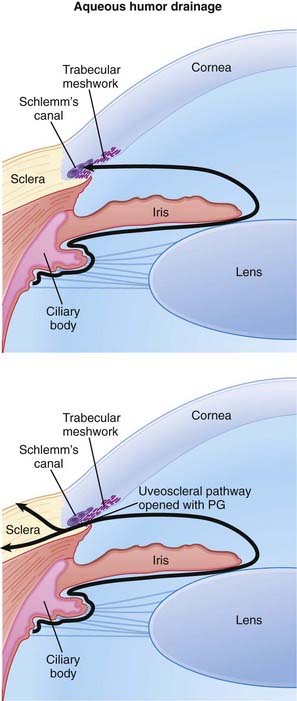Chapter 22 Ophthalmology
Ophthalmic Prostaglandins
MOA (Mechanism of Action)
 Glaucoma is characterized by increased intraocular pressure (IOP) and can lead to blindness if not treated. Strategies to reduce IOP include reducing the production and secretion of aqueous humor and facilitating its drainage.
Glaucoma is characterized by increased intraocular pressure (IOP) and can lead to blindness if not treated. Strategies to reduce IOP include reducing the production and secretion of aqueous humor and facilitating its drainage. PGs bind prostaglandin F (FP) receptors that are located on the ciliary muscle and reduce IOP by increasing outflow of aqueous humor through the uveoscleral pathway. This is thought to be accomplished through the following mechanisms:
PGs bind prostaglandin F (FP) receptors that are located on the ciliary muscle and reduce IOP by increasing outflow of aqueous humor through the uveoscleral pathway. This is thought to be accomplished through the following mechanisms: Administering exogenous PG-F (specifically PGF2α) stimulates the FP receptor and increases aqueous outflow through the mechanisms just described.
Administering exogenous PG-F (specifically PGF2α) stimulates the FP receptor and increases aqueous outflow through the mechanisms just described.Side Effects
 Local irritation: Conjunctival hyperemia (redness), itching, foreign body sensation, tearing, and eye pain are side effects.
Local irritation: Conjunctival hyperemia (redness), itching, foreign body sensation, tearing, and eye pain are side effects. Pigmentation of the iris: This occurs in patients with mixed-color irises (green-brown or blue-brown) and is a result of increased deposition of melanin. Pigmentation of the palpebral skin (eyelids) also occurs.
Pigmentation of the iris: This occurs in patients with mixed-color irises (green-brown or blue-brown) and is a result of increased deposition of melanin. Pigmentation of the palpebral skin (eyelids) also occurs. Cystoid macular edema involves accumulation of fluid in the macular area of the retina. This is a well-recognized complication of cataract surgery.
Cystoid macular edema involves accumulation of fluid in the macular area of the retina. This is a well-recognized complication of cataract surgery.

















